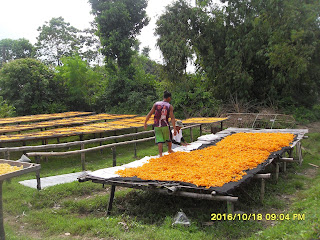It is not fish cracker; it is rice cracker. A customer who happens to be vegetarian rejoiced upon learning that the rice crackers are indeed just made of rice.
Intrigued by this difference and, of course, the novelty of the concept, we feel like we just have to go and see it for ourselves.
One day, we happened to have some curious travel bloggers and mediamen from Manila who wanted to feature lesser-known towns in Pangasinan. It proved to be the perfect opportunity, and so together we hie off to Barangay Sancagulis to the place of Romulo Castillo. Around an unassuming residence-sized factory are scattered nets filled with raw crackers laid out under the sun. The aroma of red chili stings our noses.
After seeing the unassuming signage "Sancagulis Multi-Purpose Cooperative" on the facade of an unassuming factory, we quickly learn that Castillo is not alone at it.
We hear the story of how, one day in some distant past, Castillo and his coworkers found themselves laid off from their job in Bulacan as fish cracker factory workers. They went back home to Sancagulis with no idea what to do when a lightbulb idea soon came to them: What if we put into good use our knowledge and experience in making fish crackers?
It was during President Arroyo's administration when Castillo and company decided to seek the help of the Department of Labor and Employment (DOLE). Luckily they learned about its Adjustment Measure Program or AMP, which is "a safety net program that provides package of assistance and other forms of intervention as a means of helping workers and companies cope with economic and social disruptions."
Started in 2005 with 124 members, the registered workers' organization was able to procure P1.1 million in DOLE assistance. On top of this, the Department of Science and Technology also stepped into the picture, providing help in packaging and labeling the product.
Started in 2005 with 124 members, the registered workers' organization was able to procure P1.1 million in DOLE assistance. On top of this, the Department of Science and Technology also stepped into the picture, providing help in packaging and labeling the product.
And so the Sancagulis rice cracker was born.
The response of the locals to the product was positive. We could say it's the Filipino answer to senbei, the traditional Japanese rice cracker.
The no-fish, no-gluten cracker now comes in plain (orange color and curly shaped), turmeric (yellow and square-shaped), and spicy varieties. Travel blogger Maria Rona Beltran managed to uncover some secrets from Castillo: the cracker is indeed made of plain rice but it is fortified with some corn and cassava; the rice is first steamed, then run through a food processor to flatten it and remove excess water, and then dried out in the sun and finally fried.
Currently, the factory employs 20 people working in shifts.
Carrying the barangay’s name, it can’t be helped that the
Sancagulis rice cracker is now closely associated with the place. But with their clientele
reaching as far as places outside town where beer drinkers are looking for some cheap pulutan (bar chow), it comes as no surprise that the Sancagulis rice
cracker eventually gets associated with the town of Bayambang itself.
But more than these realizations is that the Sancagulis rice cracker brand shows what building a cooperative can do.





No comments:
Post a Comment